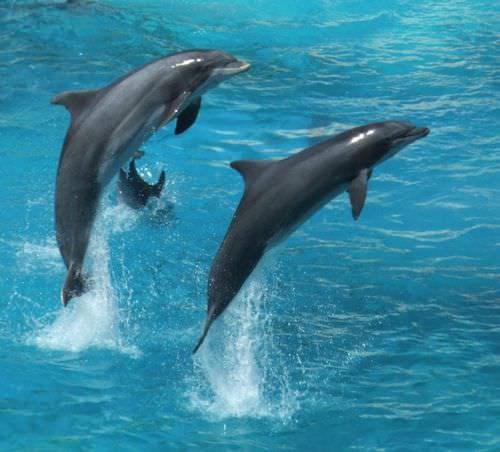10.20 哺乳动物概览
章节大纲
-
What do you have in common with a bat ?
::你和蝙蝠有什么共同点?Both humans and bats have body hair, and both humans and bats can nurse their young. These are both characteristics of mammals , the class that both bats and humans belong to.
::人类和蝙蝠都有身体毛, 人类和蝙蝠都可以喂养他们的年轻。这些都是哺乳动物的特征, 蝙蝠和人类都属于哺乳动物。Characteristics of Mammals
::哺乳动物的特点What is a mammal? These animals range from bats, cats, and rats to dogs, monkeys, elephants, and whales. They walk, run, swim, and fly. They live in the ocean, fly in the sky, walk on the prairies, and run in the savanna. There is a tremendous amount of diversity within the group in terms of , habitat , and adaptation for living in those different habitats.
::哺乳动物是什么?这些动物从蝙蝠、猫和老鼠到狗、猴子、大象和鲸鱼,它们走路、跑、游泳和飞翔。它们生活在海洋中,在天空中飞翔,在草原上行走,在草原上行走,在草原上行走。在栖息地、栖息地和适应这些不同栖息地方面,它们之间有着巨大的多样性。What allows them to live in such diverse environments? They have evolved specialized traits, unlike those of any other group of animal. Mammals (class Mammalia) are endothermic (warm-blooded) vertebrate animals with a number of unique characteristics. In most mammals, these include:
::哺乳动物(Mammalia 类)是具有若干独特特征的终极热性(温血)脊椎动物。在大多数哺乳动物中,这些动物包括:-
The presence of hair or fur.
::头发或毛皮的存在。 -
Sweat glands
.
::湿腺。 -
Glands specialized to produce milk, known as
mammary glands
.
::专门生产牛奶的腺,称为哺乳腺。 -
Three middle ear
bones
.
::三个中耳骨 -
A
neocortex
region in the
brain
, which specializes in seeing and
hearing
.
::大脑中的新生儿皮层区域 专门研究视觉和听觉 -
Specialized teeth.
::专业牙齿。 -
A four-chambered heart.
::一颗四分五裂的心
There are approximately 5,400 mammalian species , ranging in size from the tiny 1-2 inch bumblebee bat to the 108-foot blue whale. These are distributed in 29 orders, 153 families, and about 1,200 genera.
::哺乳动物物种约有5 400个,大小从小的1-2英寸大黄蜂蝙蝠到108英尺的蓝鲸不等。 它们分布在29个序列、153个家庭以及大约1 200个基因组中。There are three types of mammals, characterized by their method of reproduction. All mammals, except for a few, are viviparous , meaning they produce live young instead of laying eggs . The monotremes , however, have birdlike and reptilian characteristics, such as laying eggs and a cloaca . An example of a monotreme is the platypus with its birdlike beak and egg-laying characteristics. The echidnas are the only other monotreme mammals. A second type of mammal, the marsupial mammal, includes kangaroos, wallabies, koalas and possums. These mammals give birth to underdeveloped embryos , which then climb from the birth canal into a pouch on the front of the mother's body, where it feeds and continues to grow. The remainder of mammals, which is the majority of mammals, are placental mammals . These mammals develop in the mother's uterus , receiving nutrients across the placenta . Placental mammals include humans, rabbits, squirrels, whales, elephants, shrews, and armadillos. Dogs and cats, and sheep, cattle and horses are also placental mammals.
::哺乳动物有三种类型,以其繁殖方法为特征。所有哺乳动物,除少数哺乳动物外,都是活生生的,意思是它们生来不产卵。不过,单体动物有鸟类和爬行动物的特征,例如产卵和树脂。单体动物的一个例子是具有鸟样的甲状腺和产卵特性的甲状腺。雌雄菊动物是其他唯一的单体哺乳动物。第二种哺乳动物,哺乳动物,包括袋鼠、羊驼、牛驼和负鼠。这些哺乳动物生出发育不成熟的胚胎,这些胚胎从出生的运河爬到母体前面的袋里,它在那里喂养和继续生长。哺乳动物的其余部分是安眠哺乳动物。这些哺乳动物在母的子中发育,在胎盘中接受营养。这些哺乳动物包括人、兔子、松鼠、鲸、大象、羊、羊毛、和马驼、牛群、牛群和牛群。Mammals are also the only animal group that evolved to live on land and then back to live in the ocean. Whales, dolphins, and porpoises have all adapted from land-dwelling creatures to a life of swimming and reproducing in the water ( Figure ). Whales have evolved into the largest mammals.
::哺乳动物也是进化成在陆地上生活,然后又回到海洋中生活的唯一动物群体。 鲸鱼、海豚和海豚都从栖息于陆地的生物适应到在水中游泳和繁殖的生活(图 ) 。 鲸鱼已经演变为最大的哺乳动物。Dolphins have adapted to swimming and reproducing in water.
::海豚已经适应了游泳和在水中繁殖。Watch this TedED talk about some of the traits that are common to most mammals and some traits that distinguish mammals from one another.
::看这个TedED谈论了 多数哺乳动物共有的一些特性 以及一些区分哺乳动物的特性Summary
::摘要-
Mammals have several traits in common, including the presence of hair or fur, sweat glands, and mammary glands.
::哺乳动物有几个共同特征,包括毛发或毛皮、汗毛腺和哺乳腺。 -
Some mammals, such as dolphins and whales, evolved to live back in the ocean by adapting from land-dwelling creatures.
::一些哺乳动物,例如海豚和鲸鱼,通过适应陆地栖息生物的适应而演变成回到海洋中。
Explore More
::探索更多Use the resources below to answer the questions that follow.
::利用以下资源回答以下问题。Explore More I
::探索更多-
What is a Mammal?
at
(1:36)
::什么是哺乳动物?
-
How do mammals differ from other vertebrates?
::哺乳动物与其他脊椎动物有何不同? -
What characteristics are unique to mammals?
::哺乳动物特有的特征是什么?
Explore More II
::探索更多情况二-
Famous Fossil "Ida" (Plate B): Analysis with Dr. Robert Bakker
at
(3:17)
::著名的化石“Ida”(B板B):与Robert Bakker博士的分析(3:17)
-
What characteristics does "Ida" display?
::“ Ida” 显示什么特性 ? -
What did she probably eat based on her dentition?
::她可能吃什么了? -
What do her eyes tell us about her probable behavior?
::她的眼睛告诉我们什么 她可能的行为? -
What type of mammal was Ida? How is this known?
::艾达是哪种哺乳动物?
Review
::回顾-
What are three characteristics of mammals?
::哺乳动物的三种特征是什么? -
What is meant by viviparous?
::何谓生动无常? -
What are monotremes? Give an example.
::什么是单一的?举个例子。 -
What is the largest land mammal?
::什么是最大的陆地哺乳动物?
-
The presence of hair or fur.

